University of Derby: Financial Markets Portfolio Analysis Report
VerifiedAdded on 2021/04/16
|11
|2172
|86
Report
AI Summary
This report presents a detailed analysis of an investment portfolio, created for retirement purposes, focusing on risk minimization and return maximization. The analysis begins with a behavioral perspective on stock selection, emphasizing the choice of low-risk stocks like Wilmar International and Singapore Telecommunications. It then employs portfolio theory to determine asset allocation and mean-variance analysis. The report examines the diversification of an initial nine-asset portfolio across various sectors and evaluates its performance over the investment period, including the correlation between assets and the identification of the 'best' five assets. The Markowitz diversification process is discussed in terms of reducing risk, and the portfolio's beta and Sharpe ratio are analyzed. The report concludes by assessing the portfolio's suitability for meeting retirement goals and suggesting changes using passive management strategies. The analysis includes references to academic literature and financial concepts.
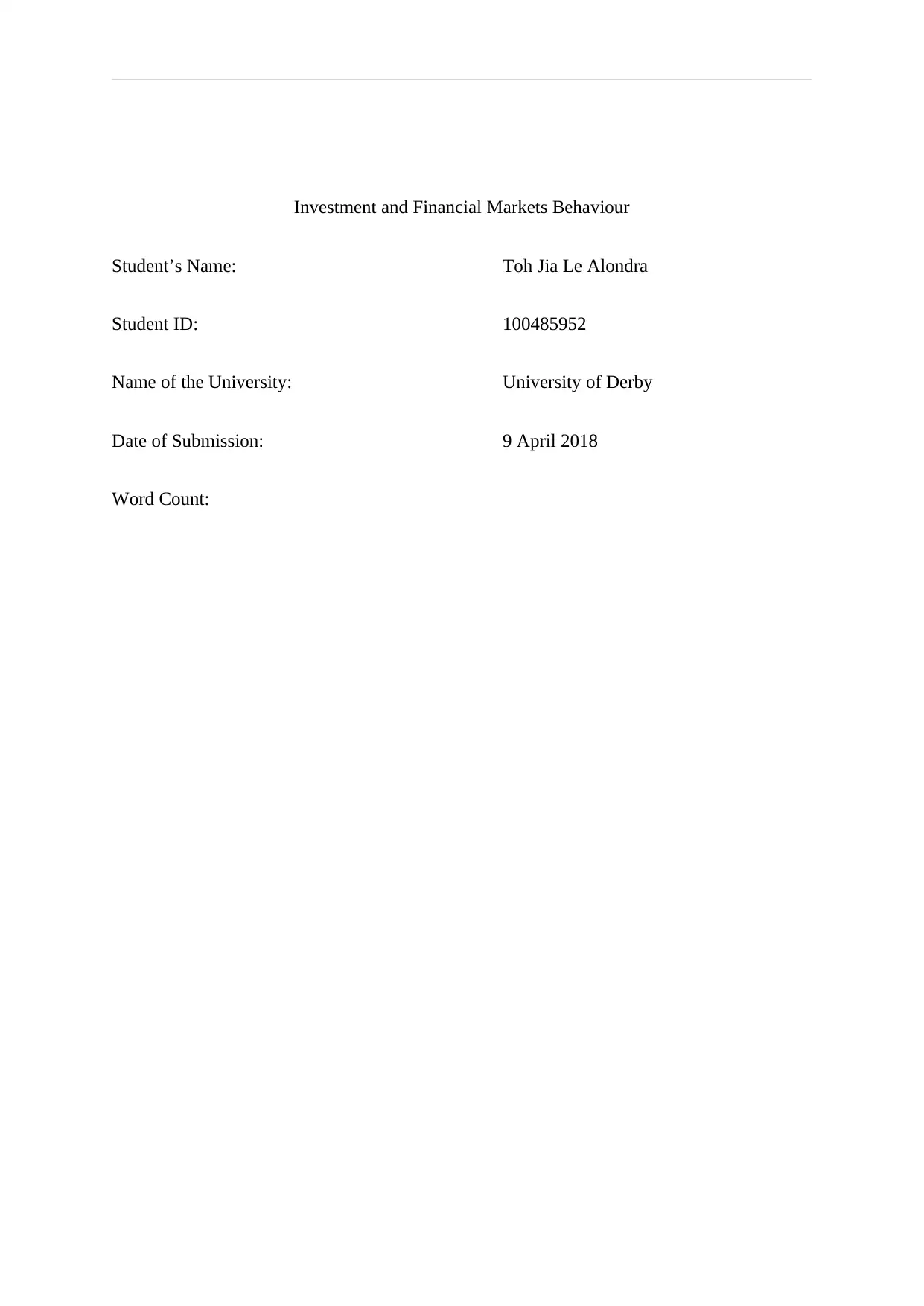
Investment and Financial Markets Behaviour
Student’s Name: Toh Jia Le Alondra
Student ID: 100485952
Name of the University: University of Derby
Date of Submission: 9 April 2018
Word Count:
Student’s Name: Toh Jia Le Alondra
Student ID: 100485952
Name of the University: University of Derby
Date of Submission: 9 April 2018
Word Count:
Paraphrase This Document
Need a fresh take? Get an instant paraphrase of this document with our AI Paraphraser
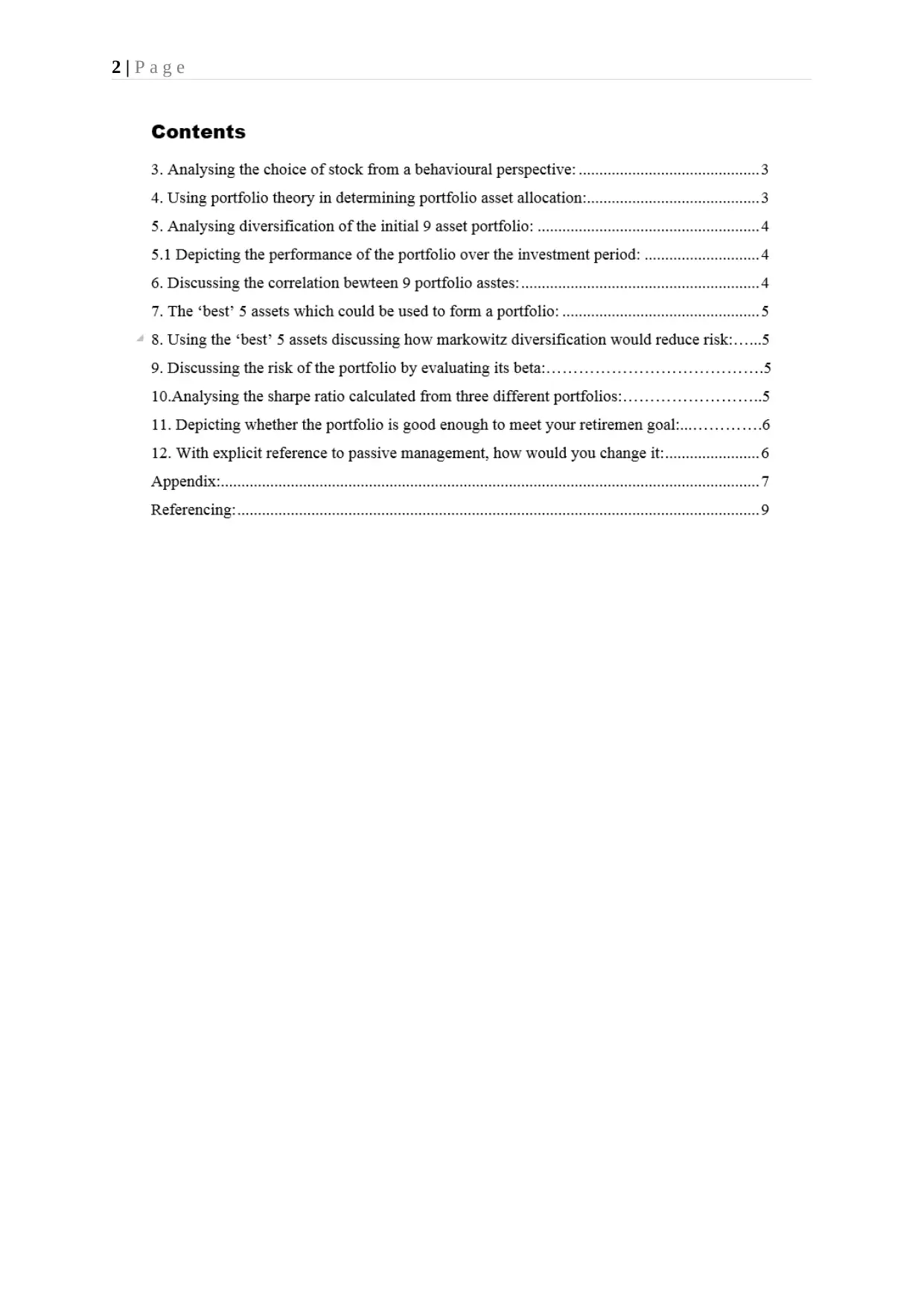
2 | P a g e
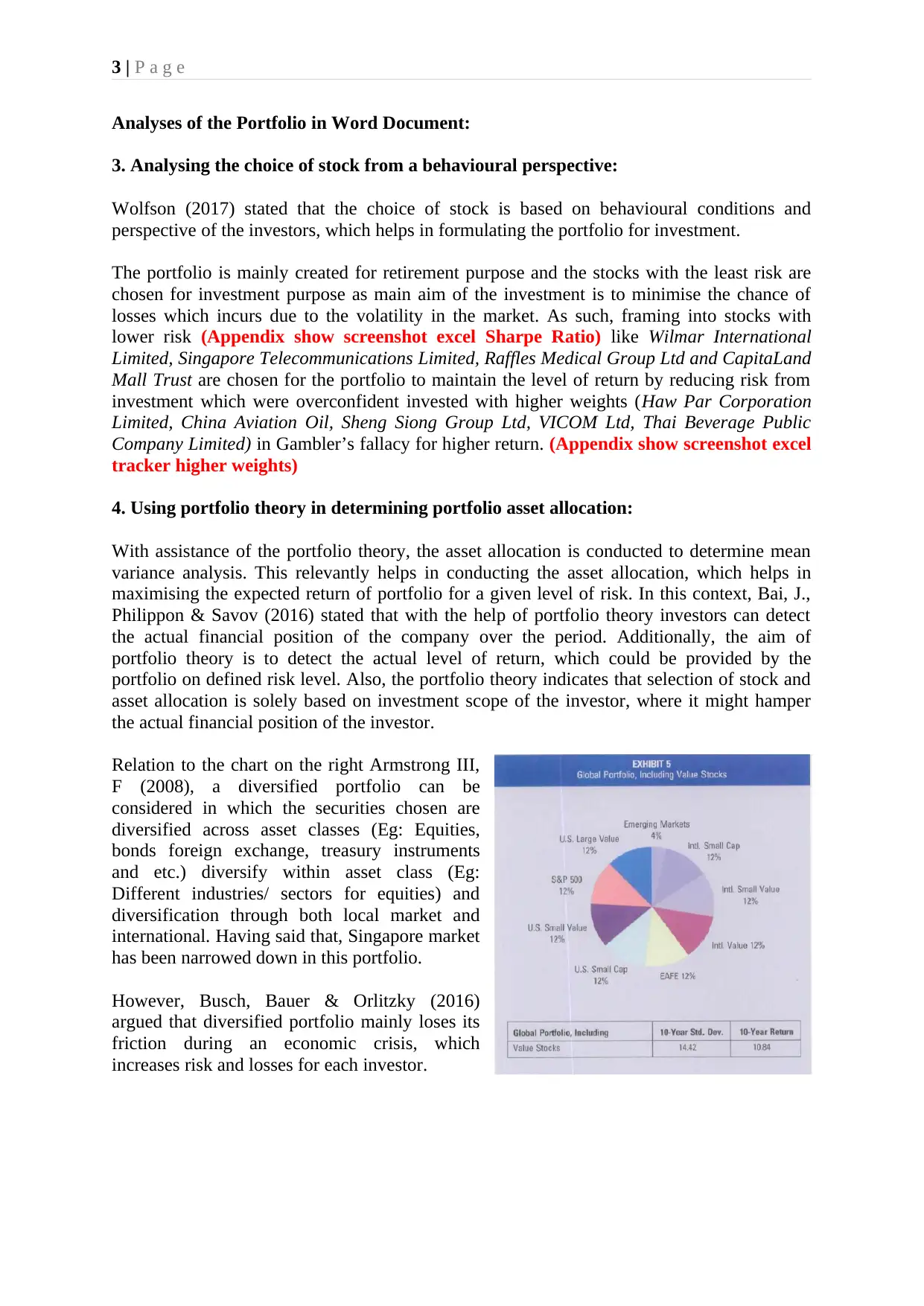
3 | P a g e
Analyses of the Portfolio in Word Document:
3. Analysing the choice of stock from a behavioural perspective:
Wolfson (2017) stated that the choice of stock is based on behavioural conditions and
perspective of the investors, which helps in formulating the portfolio for investment.
The portfolio is mainly created for retirement purpose and the stocks with the least risk are
chosen for investment purpose as main aim of the investment is to minimise the chance of
losses which incurs due to the volatility in the market. As such, framing into stocks with
lower risk (Appendix show screenshot excel Sharpe Ratio) like Wilmar International
Limited, Singapore Telecommunications Limited, Raffles Medical Group Ltd and CapitaLand
Mall Trust are chosen for the portfolio to maintain the level of return by reducing risk from
investment which were overconfident invested with higher weights (Haw Par Corporation
Limited, China Aviation Oil, Sheng Siong Group Ltd, VICOM Ltd, Thai Beverage Public
Company Limited) in Gambler’s fallacy for higher return. (Appendix show screenshot excel
tracker higher weights)
4. Using portfolio theory in determining portfolio asset allocation:
With assistance of the portfolio theory, the asset allocation is conducted to determine mean
variance analysis. This relevantly helps in conducting the asset allocation, which helps in
maximising the expected return of portfolio for a given level of risk. In this context, Bai, J.,
Philippon & Savov (2016) stated that with the help of portfolio theory investors can detect
the actual financial position of the company over the period. Additionally, the aim of
portfolio theory is to detect the actual level of return, which could be provided by the
portfolio on defined risk level. Also, the portfolio theory indicates that selection of stock and
asset allocation is solely based on investment scope of the investor, where it might hamper
the actual financial position of the investor.
Relation to the chart on the right Armstrong III,
F (2008), a diversified portfolio can be
considered in which the securities chosen are
diversified across asset classes (Eg: Equities,
bonds foreign exchange, treasury instruments
and etc.) diversify within asset class (Eg:
Different industries/ sectors for equities) and
diversification through both local market and
international. Having said that, Singapore market
has been narrowed down in this portfolio.
However, Busch, Bauer & Orlitzky (2016)
argued that diversified portfolio mainly loses its
friction during an economic crisis, which
increases risk and losses for each investor.
Analyses of the Portfolio in Word Document:
3. Analysing the choice of stock from a behavioural perspective:
Wolfson (2017) stated that the choice of stock is based on behavioural conditions and
perspective of the investors, which helps in formulating the portfolio for investment.
The portfolio is mainly created for retirement purpose and the stocks with the least risk are
chosen for investment purpose as main aim of the investment is to minimise the chance of
losses which incurs due to the volatility in the market. As such, framing into stocks with
lower risk (Appendix show screenshot excel Sharpe Ratio) like Wilmar International
Limited, Singapore Telecommunications Limited, Raffles Medical Group Ltd and CapitaLand
Mall Trust are chosen for the portfolio to maintain the level of return by reducing risk from
investment which were overconfident invested with higher weights (Haw Par Corporation
Limited, China Aviation Oil, Sheng Siong Group Ltd, VICOM Ltd, Thai Beverage Public
Company Limited) in Gambler’s fallacy for higher return. (Appendix show screenshot excel
tracker higher weights)
4. Using portfolio theory in determining portfolio asset allocation:
With assistance of the portfolio theory, the asset allocation is conducted to determine mean
variance analysis. This relevantly helps in conducting the asset allocation, which helps in
maximising the expected return of portfolio for a given level of risk. In this context, Bai, J.,
Philippon & Savov (2016) stated that with the help of portfolio theory investors can detect
the actual financial position of the company over the period. Additionally, the aim of
portfolio theory is to detect the actual level of return, which could be provided by the
portfolio on defined risk level. Also, the portfolio theory indicates that selection of stock and
asset allocation is solely based on investment scope of the investor, where it might hamper
the actual financial position of the investor.
Relation to the chart on the right Armstrong III,
F (2008), a diversified portfolio can be
considered in which the securities chosen are
diversified across asset classes (Eg: Equities,
bonds foreign exchange, treasury instruments
and etc.) diversify within asset class (Eg:
Different industries/ sectors for equities) and
diversification through both local market and
international. Having said that, Singapore market
has been narrowed down in this portfolio.
However, Busch, Bauer & Orlitzky (2016)
argued that diversified portfolio mainly loses its
friction during an economic crisis, which
increases risk and losses for each investor.
⊘ This is a preview!⊘
Do you want full access?
Subscribe today to unlock all pages.

Trusted by 1+ million students worldwide
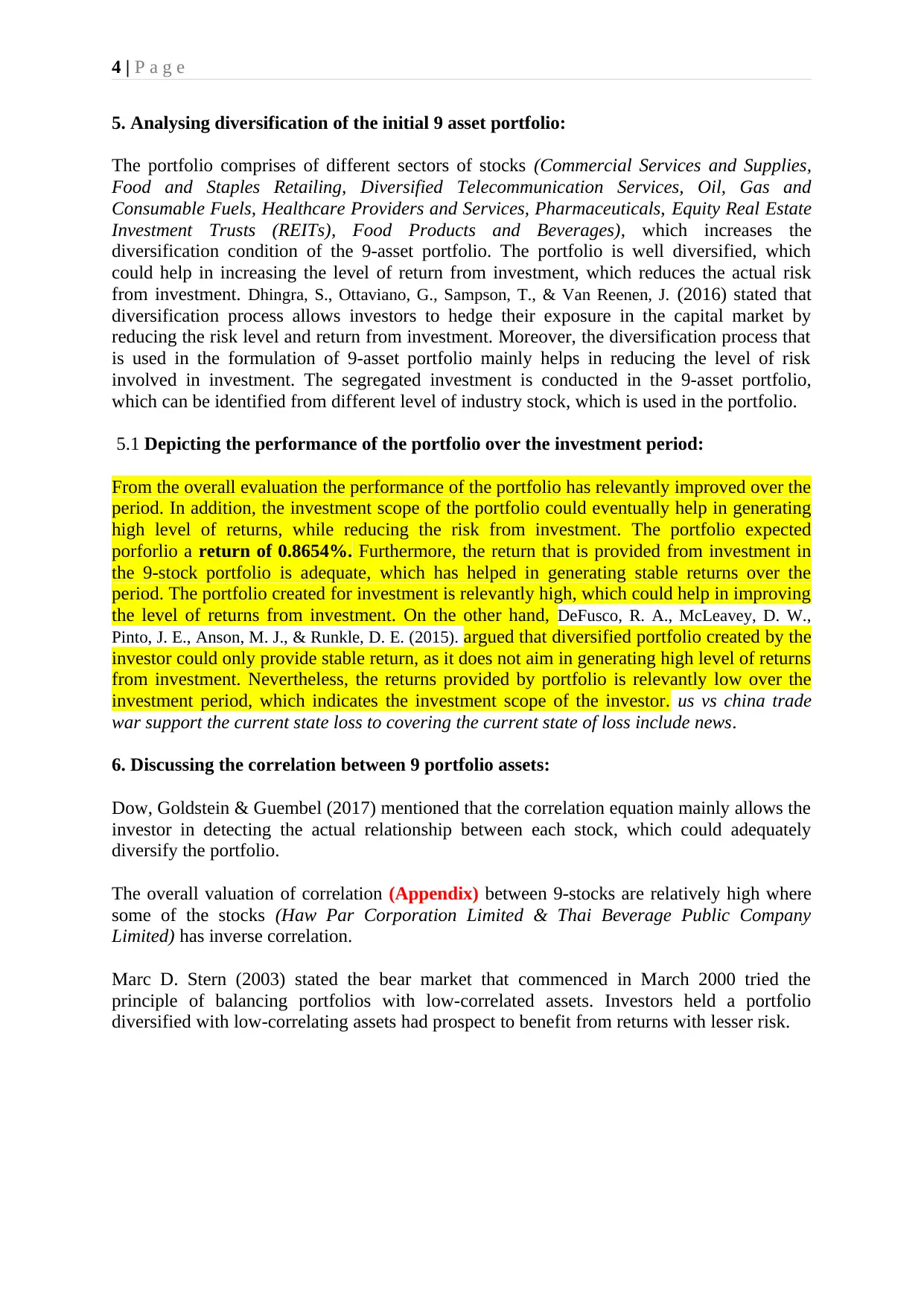
4 | P a g e
5. Analysing diversification of the initial 9 asset portfolio:
The portfolio comprises of different sectors of stocks (Commercial Services and Supplies,
Food and Staples Retailing, Diversified Telecommunication Services, Oil, Gas and
Consumable Fuels, Healthcare Providers and Services, Pharmaceuticals, Equity Real Estate
Investment Trusts (REITs), Food Products and Beverages), which increases the
diversification condition of the 9-asset portfolio. The portfolio is well diversified, which
could help in increasing the level of return from investment, which reduces the actual risk
from investment. Dhingra, S., Ottaviano, G., Sampson, T., & Van Reenen, J. (2016) stated that
diversification process allows investors to hedge their exposure in the capital market by
reducing the risk level and return from investment. Moreover, the diversification process that
is used in the formulation of 9-asset portfolio mainly helps in reducing the level of risk
involved in investment. The segregated investment is conducted in the 9-asset portfolio,
which can be identified from different level of industry stock, which is used in the portfolio.
5.1 Depicting the performance of the portfolio over the investment period:
From the overall evaluation the performance of the portfolio has relevantly improved over the
period. In addition, the investment scope of the portfolio could eventually help in generating
high level of returns, while reducing the risk from investment. The portfolio expected
porforlio a return of 0.8654%. Furthermore, the return that is provided from investment in
the 9-stock portfolio is adequate, which has helped in generating stable returns over the
period. The portfolio created for investment is relevantly high, which could help in improving
the level of returns from investment. On the other hand, DeFusco, R. A., McLeavey, D. W.,
Pinto, J. E., Anson, M. J., & Runkle, D. E. (2015). argued that diversified portfolio created by the
investor could only provide stable return, as it does not aim in generating high level of returns
from investment. Nevertheless, the returns provided by portfolio is relevantly low over the
investment period, which indicates the investment scope of the investor. us vs china trade
war support the current state loss to covering the current state of loss include news.
6. Discussing the correlation between 9 portfolio assets:
Dow, Goldstein & Guembel (2017) mentioned that the correlation equation mainly allows the
investor in detecting the actual relationship between each stock, which could adequately
diversify the portfolio.
The overall valuation of correlation (Appendix) between 9-stocks are relatively high where
some of the stocks (Haw Par Corporation Limited & Thai Beverage Public Company
Limited) has inverse correlation.
Marc D. Stern (2003) stated the bear market that commenced in March 2000 tried the
principle of balancing portfolios with low-correlated assets. Investors held a portfolio
diversified with low-correlating assets had prospect to benefit from returns with lesser risk.
5. Analysing diversification of the initial 9 asset portfolio:
The portfolio comprises of different sectors of stocks (Commercial Services and Supplies,
Food and Staples Retailing, Diversified Telecommunication Services, Oil, Gas and
Consumable Fuels, Healthcare Providers and Services, Pharmaceuticals, Equity Real Estate
Investment Trusts (REITs), Food Products and Beverages), which increases the
diversification condition of the 9-asset portfolio. The portfolio is well diversified, which
could help in increasing the level of return from investment, which reduces the actual risk
from investment. Dhingra, S., Ottaviano, G., Sampson, T., & Van Reenen, J. (2016) stated that
diversification process allows investors to hedge their exposure in the capital market by
reducing the risk level and return from investment. Moreover, the diversification process that
is used in the formulation of 9-asset portfolio mainly helps in reducing the level of risk
involved in investment. The segregated investment is conducted in the 9-asset portfolio,
which can be identified from different level of industry stock, which is used in the portfolio.
5.1 Depicting the performance of the portfolio over the investment period:
From the overall evaluation the performance of the portfolio has relevantly improved over the
period. In addition, the investment scope of the portfolio could eventually help in generating
high level of returns, while reducing the risk from investment. The portfolio expected
porforlio a return of 0.8654%. Furthermore, the return that is provided from investment in
the 9-stock portfolio is adequate, which has helped in generating stable returns over the
period. The portfolio created for investment is relevantly high, which could help in improving
the level of returns from investment. On the other hand, DeFusco, R. A., McLeavey, D. W.,
Pinto, J. E., Anson, M. J., & Runkle, D. E. (2015). argued that diversified portfolio created by the
investor could only provide stable return, as it does not aim in generating high level of returns
from investment. Nevertheless, the returns provided by portfolio is relevantly low over the
investment period, which indicates the investment scope of the investor. us vs china trade
war support the current state loss to covering the current state of loss include news.
6. Discussing the correlation between 9 portfolio assets:
Dow, Goldstein & Guembel (2017) mentioned that the correlation equation mainly allows the
investor in detecting the actual relationship between each stock, which could adequately
diversify the portfolio.
The overall valuation of correlation (Appendix) between 9-stocks are relatively high where
some of the stocks (Haw Par Corporation Limited & Thai Beverage Public Company
Limited) has inverse correlation.
Marc D. Stern (2003) stated the bear market that commenced in March 2000 tried the
principle of balancing portfolios with low-correlated assets. Investors held a portfolio
diversified with low-correlating assets had prospect to benefit from returns with lesser risk.
Paraphrase This Document
Need a fresh take? Get an instant paraphrase of this document with our AI Paraphraser
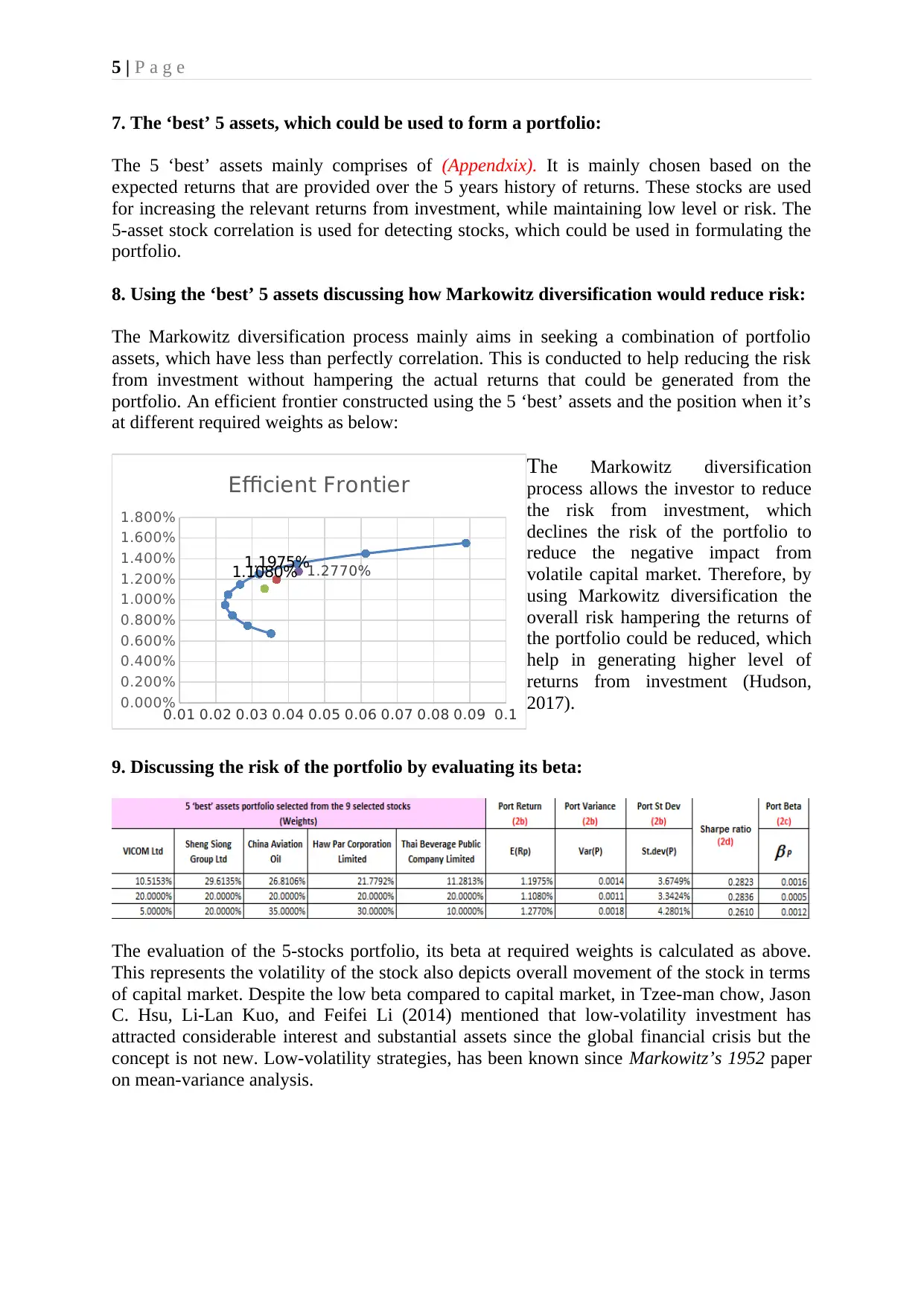
5 | P a g e
7. The ‘best’ 5 assets, which could be used to form a portfolio:
The 5 ‘best’ assets mainly comprises of (Appendxix). It is mainly chosen based on the
expected returns that are provided over the 5 years history of returns. These stocks are used
for increasing the relevant returns from investment, while maintaining low level or risk. The
5-asset stock correlation is used for detecting stocks, which could be used in formulating the
portfolio.
8. Using the ‘best’ 5 assets discussing how Markowitz diversification would reduce risk:
The Markowitz diversification process mainly aims in seeking a combination of portfolio
assets, which have less than perfectly correlation. This is conducted to help reducing the risk
from investment without hampering the actual returns that could be generated from the
portfolio. An efficient frontier constructed using the 5 ‘best’ assets and the position when it’s
at different required weights as below:
The Markowitz diversification
process allows the investor to reduce
the risk from investment, which
declines the risk of the portfolio to
reduce the negative impact from
volatile capital market. Therefore, by
using Markowitz diversification the
overall risk hampering the returns of
the portfolio could be reduced, which
help in generating higher level of
returns from investment (Hudson,
2017).
9. Discussing the risk of the portfolio by evaluating its beta:
The evaluation of the 5-stocks portfolio, its beta at required weights is calculated as above.
This represents the volatility of the stock also depicts overall movement of the stock in terms
of capital market. Despite the low beta compared to capital market, in Tzee-man chow, Jason
C. Hsu, Li-Lan Kuo, and Feifei Li (2014) mentioned that low-volatility investment has
attracted considerable interest and substantial assets since the global financial crisis but the
concept is not new. Low-volatility strategies, has been known since Markowitz’s 1952 paper
on mean-variance analysis.
0.01 0.02 0.03 0.04 0.05 0.06 0.07 0.08 0.09 0.1
0.000%
0.200%
0.400%
0.600%
0.800%
1.000%
1.200%
1.400%
1.600%
1.800%
1.2770%1.1080%
1.1975%
Efficient Frontier
7. The ‘best’ 5 assets, which could be used to form a portfolio:
The 5 ‘best’ assets mainly comprises of (Appendxix). It is mainly chosen based on the
expected returns that are provided over the 5 years history of returns. These stocks are used
for increasing the relevant returns from investment, while maintaining low level or risk. The
5-asset stock correlation is used for detecting stocks, which could be used in formulating the
portfolio.
8. Using the ‘best’ 5 assets discussing how Markowitz diversification would reduce risk:
The Markowitz diversification process mainly aims in seeking a combination of portfolio
assets, which have less than perfectly correlation. This is conducted to help reducing the risk
from investment without hampering the actual returns that could be generated from the
portfolio. An efficient frontier constructed using the 5 ‘best’ assets and the position when it’s
at different required weights as below:
The Markowitz diversification
process allows the investor to reduce
the risk from investment, which
declines the risk of the portfolio to
reduce the negative impact from
volatile capital market. Therefore, by
using Markowitz diversification the
overall risk hampering the returns of
the portfolio could be reduced, which
help in generating higher level of
returns from investment (Hudson,
2017).
9. Discussing the risk of the portfolio by evaluating its beta:
The evaluation of the 5-stocks portfolio, its beta at required weights is calculated as above.
This represents the volatility of the stock also depicts overall movement of the stock in terms
of capital market. Despite the low beta compared to capital market, in Tzee-man chow, Jason
C. Hsu, Li-Lan Kuo, and Feifei Li (2014) mentioned that low-volatility investment has
attracted considerable interest and substantial assets since the global financial crisis but the
concept is not new. Low-volatility strategies, has been known since Markowitz’s 1952 paper
on mean-variance analysis.
0.01 0.02 0.03 0.04 0.05 0.06 0.07 0.08 0.09 0.1
0.000%
0.200%
0.400%
0.600%
0.800%
1.000%
1.200%
1.400%
1.600%
1.800%
1.2770%1.1080%
1.1975%
Efficient Frontier
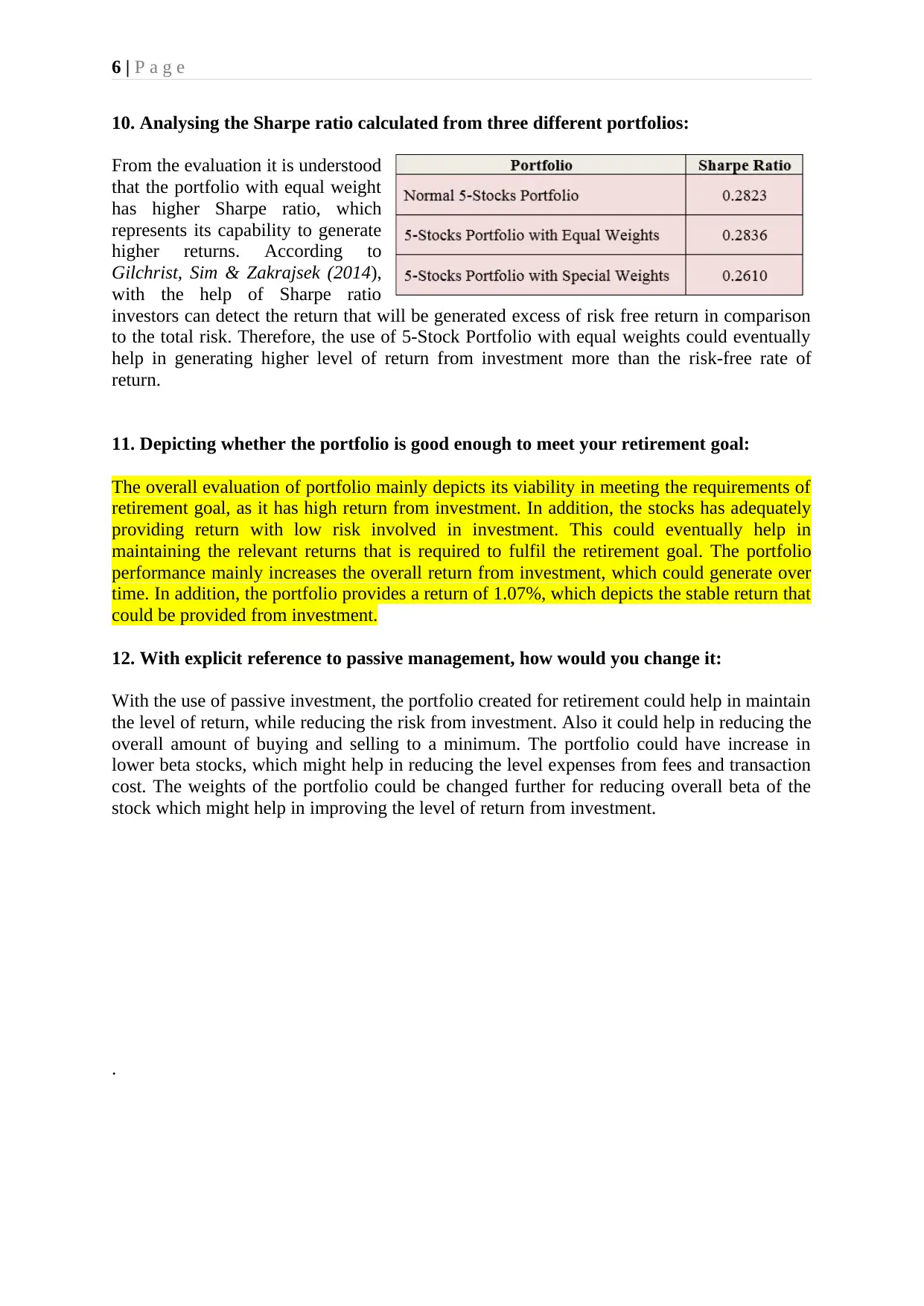
6 | P a g e
10. Analysing the Sharpe ratio calculated from three different portfolios:
From the evaluation it is understood
that the portfolio with equal weight
has higher Sharpe ratio, which
represents its capability to generate
higher returns. According to
Gilchrist, Sim & Zakrajsek (2014),
with the help of Sharpe ratio
investors can detect the return that will be generated excess of risk free return in comparison
to the total risk. Therefore, the use of 5-Stock Portfolio with equal weights could eventually
help in generating higher level of return from investment more than the risk-free rate of
return.
11. Depicting whether the portfolio is good enough to meet your retirement goal:
The overall evaluation of portfolio mainly depicts its viability in meeting the requirements of
retirement goal, as it has high return from investment. In addition, the stocks has adequately
providing return with low risk involved in investment. This could eventually help in
maintaining the relevant returns that is required to fulfil the retirement goal. The portfolio
performance mainly increases the overall return from investment, which could generate over
time. In addition, the portfolio provides a return of 1.07%, which depicts the stable return that
could be provided from investment.
12. With explicit reference to passive management, how would you change it:
With the use of passive investment, the portfolio created for retirement could help in maintain
the level of return, while reducing the risk from investment. Also it could help in reducing the
overall amount of buying and selling to a minimum. The portfolio could have increase in
lower beta stocks, which might help in reducing the level expenses from fees and transaction
cost. The weights of the portfolio could be changed further for reducing overall beta of the
stock which might help in improving the level of return from investment.
.
10. Analysing the Sharpe ratio calculated from three different portfolios:
From the evaluation it is understood
that the portfolio with equal weight
has higher Sharpe ratio, which
represents its capability to generate
higher returns. According to
Gilchrist, Sim & Zakrajsek (2014),
with the help of Sharpe ratio
investors can detect the return that will be generated excess of risk free return in comparison
to the total risk. Therefore, the use of 5-Stock Portfolio with equal weights could eventually
help in generating higher level of return from investment more than the risk-free rate of
return.
11. Depicting whether the portfolio is good enough to meet your retirement goal:
The overall evaluation of portfolio mainly depicts its viability in meeting the requirements of
retirement goal, as it has high return from investment. In addition, the stocks has adequately
providing return with low risk involved in investment. This could eventually help in
maintaining the relevant returns that is required to fulfil the retirement goal. The portfolio
performance mainly increases the overall return from investment, which could generate over
time. In addition, the portfolio provides a return of 1.07%, which depicts the stable return that
could be provided from investment.
12. With explicit reference to passive management, how would you change it:
With the use of passive investment, the portfolio created for retirement could help in maintain
the level of return, while reducing the risk from investment. Also it could help in reducing the
overall amount of buying and selling to a minimum. The portfolio could have increase in
lower beta stocks, which might help in reducing the level expenses from fees and transaction
cost. The weights of the portfolio could be changed further for reducing overall beta of the
stock which might help in improving the level of return from investment.
.
⊘ This is a preview!⊘
Do you want full access?
Subscribe today to unlock all pages.

Trusted by 1+ million students worldwide

7 | P a g e
Paraphrase This Document
Need a fresh take? Get an instant paraphrase of this document with our AI Paraphraser

8 | P a g e

9 | P a g e
Referencing
Wolfson, M. H. (2017). Financial crises: Understanding the postwar US experience.
Routledge. (Assessed: 1-April-2018)
Bai, J., Philippon, T., & Savov, A. (2016). Have financial markets become more
informative?. Journal of Financial Economics, 122(3), 625-654. [Online] (Assessed: 3-April-
2018)
Armstrong III, F (2008), ‘How Much Diversification Is Enough?’, CPA Journal, 78, 1, pp.
51-52, Business Source Premier, EBSCOhost, (Assessed: 4-April-2018)
Busch, T., Bauer, R., & Orlitzky, M. (2016). Sustainable development and financial markets:
Old paths and new avenues. Business & Society, 55(3), 303-329. (Assessed: 31-March-2018)
Dhingra, S., Ottaviano, G., Sampson, T., & Van Reenen, J. (2016). The impact of Brexit on
foreign investment in the UK. BREXIT 2016, 24. (Assessed: 29-March-2018)
DeFusco, R. A., McLeavey, D. W., Pinto, J. E., Anson, M. J., & Runkle, D. E.
(2015). Quantitative investment analysis. John Wiley & Sons. (Assessed: 30-March-2018)
Dow, J., Goldstein, I., & Guembel, A. (2017). Incentives for information production in
markets where prices affect real investment. Journal of the European Economic
Association, 15(4), 877-909. (Assessed: 1-April-2018)
Marc D. Stern (2006), ‘The Long View’. The Power of Low-Correlation Investing. CPA
Journal, [Online] Available at:
http://archives.cpajournal.com/2003/1103/features/f114203.htm (Assessed: 5-April-2018)
Hudson, A. (2017). The law on financial derivatives. Sweet and Maxwell Ltd. (Assessed: 1-
April-2018)
Tzee-man chow, Jason C. Hsu, Li-Lan Kuo, and Feifei Li (2014), A Study of Low-Volatility
Portfolio Construction Method. IIJ, 440, 4 [Online] Available at:
https://www.anderson.ucla.edu/Documents/areas/prg/mfe/Tzee%20Mann%20Chow
%20JPM_Summer_2014_RA.pdf (Assessed: 5-April-2018)
Gilchrist, S., Sim, J. W., & Zakrajšek, E. (2014). Uncertainty, financial frictions, and
investment dynamics (No. w20038). National Bureau of Economic Research. (Assessed: 2-
April-2018)
Eg:
Referencing
Wolfson, M. H. (2017). Financial crises: Understanding the postwar US experience.
Routledge. (Assessed: 1-April-2018)
Bai, J., Philippon, T., & Savov, A. (2016). Have financial markets become more
informative?. Journal of Financial Economics, 122(3), 625-654. [Online] (Assessed: 3-April-
2018)
Armstrong III, F (2008), ‘How Much Diversification Is Enough?’, CPA Journal, 78, 1, pp.
51-52, Business Source Premier, EBSCOhost, (Assessed: 4-April-2018)
Busch, T., Bauer, R., & Orlitzky, M. (2016). Sustainable development and financial markets:
Old paths and new avenues. Business & Society, 55(3), 303-329. (Assessed: 31-March-2018)
Dhingra, S., Ottaviano, G., Sampson, T., & Van Reenen, J. (2016). The impact of Brexit on
foreign investment in the UK. BREXIT 2016, 24. (Assessed: 29-March-2018)
DeFusco, R. A., McLeavey, D. W., Pinto, J. E., Anson, M. J., & Runkle, D. E.
(2015). Quantitative investment analysis. John Wiley & Sons. (Assessed: 30-March-2018)
Dow, J., Goldstein, I., & Guembel, A. (2017). Incentives for information production in
markets where prices affect real investment. Journal of the European Economic
Association, 15(4), 877-909. (Assessed: 1-April-2018)
Marc D. Stern (2006), ‘The Long View’. The Power of Low-Correlation Investing. CPA
Journal, [Online] Available at:
http://archives.cpajournal.com/2003/1103/features/f114203.htm (Assessed: 5-April-2018)
Hudson, A. (2017). The law on financial derivatives. Sweet and Maxwell Ltd. (Assessed: 1-
April-2018)
Tzee-man chow, Jason C. Hsu, Li-Lan Kuo, and Feifei Li (2014), A Study of Low-Volatility
Portfolio Construction Method. IIJ, 440, 4 [Online] Available at:
https://www.anderson.ucla.edu/Documents/areas/prg/mfe/Tzee%20Mann%20Chow
%20JPM_Summer_2014_RA.pdf (Assessed: 5-April-2018)
Gilchrist, S., Sim, J. W., & Zakrajšek, E. (2014). Uncertainty, financial frictions, and
investment dynamics (No. w20038). National Bureau of Economic Research. (Assessed: 2-
April-2018)
Eg:
⊘ This is a preview!⊘
Do you want full access?
Subscribe today to unlock all pages.

Trusted by 1+ million students worldwide

10 | P a g e
*Title needs to be italic, underline or bold
*Title needs to be italic, underline or bold
Paraphrase This Document
Need a fresh take? Get an instant paraphrase of this document with our AI Paraphraser

11 | P a g e
1 out of 11
Related Documents
Your All-in-One AI-Powered Toolkit for Academic Success.
+13062052269
info@desklib.com
Available 24*7 on WhatsApp / Email
![[object Object]](/_next/static/media/star-bottom.7253800d.svg)
Unlock your academic potential
Copyright © 2020–2025 A2Z Services. All Rights Reserved. Developed and managed by ZUCOL.





